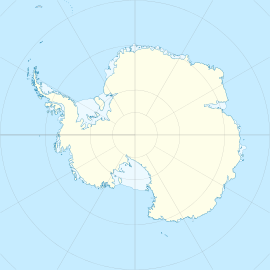Ice Runway
Ice Runway | |||||||||||||||
|---|---|---|---|---|---|---|---|---|---|---|---|---|---|---|---|
 C-5 Galaxy unloading at sea ice runway, near McMurdo Station, 1999. | |||||||||||||||
| Summary | |||||||||||||||
| Location | McMurdo Sound, Antarctica | ||||||||||||||
| Elevation AMSL | 1 ft / 0 m | ||||||||||||||
| Coordinates | 77°51′14″S 166°28′07″E / 77.85389°S 166.46861°E | ||||||||||||||
| Map | |||||||||||||||
 | |||||||||||||||
| Runways | |||||||||||||||
| |||||||||||||||

The Annual Sea-Ice Runway (ICAO: NZIR) [3] was the principal runway for the U.S. Antarctic Program during the summer Antarctic field season due to its proximity to McMurdo Station, until 2017. The present two runways in the area are the snow runway at Williams Field (NZWD) and the compacted snow runway at Phoenix Airfield (NZFX), which replaced Pegasus Field (NZPG) in 2017.
The sea ice runway was capable of handling wheeled aircraft, which have included to date: Lockheed C-5 Galaxy, Lockheed C-141 Starlifter, Boeing C-17 Globemaster III, Lockheed C-130 Hercules and Lockheed P-3 Orion. In the summer season of 2009/2010 the RNZAF trialed a modified Boeing 757 operationally. The intention is to use the Boeing 757 for passenger transport, thereby freeing up capacity for C-17 cargo space.[4]
The annual sea-ice runway for wheeled aircraft was constructed at the start of each season and used until early December when the sea ice began to break up.[5] Subsequently, flight operations were moved back to Williams Field. Pilots landing C-17 Globemaster III cargo aircraft on the sea ice runway reported that the surface was stable, not unlike landing on concrete. The similarity with land bases ended when the jet aircraft rolled to a stop, however. The nearly 450,000 pound (= 201 tons) weight of the plane, including cargo and passengers, caused it to sink into the ice, albeit only a matter of inches. A laser light was trained on the aircraft to measure the settlement rate. The $200 million aircraft was moved to a new location on the six-foot-thick ice as a safety measure if the 10-inch red line was reached, according to the News Tribune in Tacoma, Washington.[citation needed]
Decommissioning
[edit]Whilst no formal records have been located of a permanent decommissioning of the McMurdo sea-ice runway, interest in eliminating its use began with the development of Pegasus Field in 1992.[6] Concept studies were commenced into the possibility of downscaling from three McMurdo airports to two or one, leading to Pegasus being trialled as a replacement for the sea-ice runway at the start of the annual summer season in 2008-09.[7] Based on the results of this work proving that Pegasus Field was unsuitable for use during the warmer part of the summer due to excessive snow melt, the development of Phoenix Airfield was commenced in 2014 with the intention of it being capable of operating for wheeled aircraft throughout the entire summer, thus proving the single airport concept. [8] Following the 2017 opening of Phoenix Field, all references to the sea-ice runway were removed from the USAP website [9] and official documentation. [10]
The sea-ice runway site is still shown in flight tracking [11][12] and airport information [1][2] websites, leaving unresolved the question of its current official status. However, it has never been a fixed permanent location in any of its years of operation because of the annual melting of the ice in McMurdo Sound during the Antarctic summer.
Accidents and incidents
[edit]- 18 October 1956: a Lockheed P2V-2N Neptune (122465) of the US Navy crashed on landing, killing 4 of the 8 occupants. The Neptune was arriving from Christchurch without enough fuel to turn back and weather at McMurdo was storming; the plane suddenly turned right and the nose fell during landing, and the Neptune was demolished on impact.[13]
- 31 October 1960: a United States Navy Lockheed EC-121 Warning Star from Oceanographic Development Squadron Eight crashed while attempting to land on the Ice Runway. The pilot and co-pilot were badly injured, but the other crew received minor injuries or were uninjured. The aircraft was not recovered, and was simply allowed to sink when the ice melted in the spring.[14][15]
See also
[edit]References
[edit]- ^ a b "Airport information for NZIR". World Aero Data. Archived from the original on 2019-03-05.
{{cite web}}: CS1 maint: unfit URL (link) Data current as of October 2006. Source: DAFIF. - ^ a b Airport information for NZIR at Great Circle Mapper. Source: DAFIF (effective October 2006).
- ^ "Aircraft Landing Areas". Archived from the original on 2017-05-28.
- ^ "Royal New Zealand Air Force".
- ^ Blue-ice and snow runways, National Science Foundation Office of Polar Programs. April 9, 1993.
- ^ "Phoenix Airfield Rising".
- ^ "McMurdo Consolidated Airfields Study" (PDF).
- ^ "A New Runway for McMurdo Station is Named".
- ^ "Aircraft Landing Areas". Archived from the original on 2018-09-19.
- ^ "US Antarctic Program Interagency Air Operations Manual" (PDF). 1 August 2017. Archived from the original (PDF) on 2019-10-15.
- ^ "McMurdo Ice Runway".
- ^ "MCMURDO SEA ICE RUNWAY AIRPORT (ANTARCTICA) NZIR".
- ^ "ASN Aircraft accident Lockheed P2V-2N Neptune 122465 McMurdo Station". aviation-safety.net. Retrieved 2023-08-09.
- ^ DeRoo, Ricky (2005). "Navy WV-2 Super Connie Crash at McMurdo Sound in 1960". Retrieved 2 June 2015.
- ^ "Accident description". Aviation Safety Network. Retrieved 2 June 2015.
External links
[edit]- Ambling through Ice Town, Antarctic Sun. November 28, 1999.


